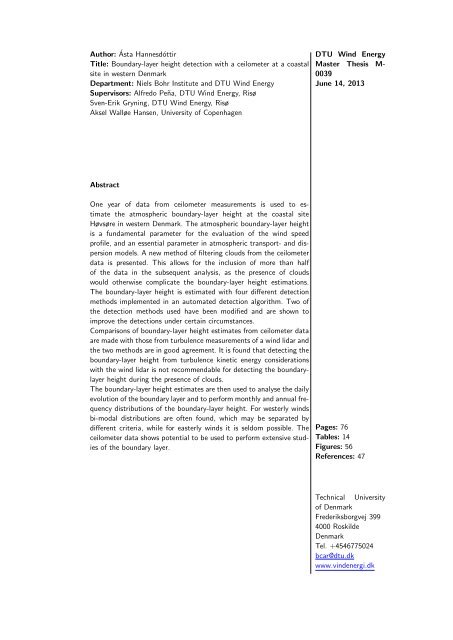Boundary-layer height detection with a ceilometer at a coastal ... - Orbit
Boundary-layer height detection with a ceilometer at a coastal ... - Orbit
Boundary-layer height detection with a ceilometer at a coastal ... - Orbit
You also want an ePaper? Increase the reach of your titles
YUMPU automatically turns print PDFs into web optimized ePapers that Google loves.
Author: Ásta Hannesdóttir<br />
Title: <strong>Boundary</strong>-<strong>layer</strong> <strong>height</strong> <strong>detection</strong> <strong>with</strong> a <strong>ceilometer</strong> <strong>at</strong> a <strong>coastal</strong><br />
site in western Denmark<br />
Department: Niels Bohr Institute and DTU Wind Energy<br />
Supervisors: Alfredo Peña, DTU Wind Energy, Risø<br />
Sven-Erik Gryning, DTU Wind Energy, Risø<br />
Aksel Walløe Hansen, University of Copenhagen<br />
DTU Wind Energy<br />
Master Thesis M-<br />
0039<br />
June 14, 2013<br />
Abstract<br />
One year of d<strong>at</strong>a from <strong>ceilometer</strong> measurements is used to estim<strong>at</strong>e<br />
the <strong>at</strong>mospheric boundary-<strong>layer</strong> <strong>height</strong> <strong>at</strong> the <strong>coastal</strong> site<br />
Høvsøre in western Denmark. The <strong>at</strong>mospheric boundary-<strong>layer</strong> <strong>height</strong><br />
is a fundamental parameter for the evalu<strong>at</strong>ion of the wind speed<br />
profile, and an essential parameter in <strong>at</strong>mospheric transport- and dispersion<br />
models. A new method of filtering clouds from the <strong>ceilometer</strong><br />
d<strong>at</strong>a is presented. This allows for the inclusion of more than half<br />
of the d<strong>at</strong>a in the subsequent analysis, as the presence of clouds<br />
would otherwise complic<strong>at</strong>e the boundary-<strong>layer</strong> <strong>height</strong> estim<strong>at</strong>ions.<br />
The boundary-<strong>layer</strong> <strong>height</strong> is estim<strong>at</strong>ed <strong>with</strong> four different <strong>detection</strong><br />
methods implemented in an autom<strong>at</strong>ed <strong>detection</strong> algorithm. Two of<br />
the <strong>detection</strong> methods used have been modified and are shown to<br />
improve the <strong>detection</strong>s under certain circumstances.<br />
Comparisons of boundary-<strong>layer</strong> <strong>height</strong> estim<strong>at</strong>es from <strong>ceilometer</strong> d<strong>at</strong>a<br />
are made <strong>with</strong> those from turbulence measurements of a wind lidar and<br />
the two methods are in good agreement. It is found th<strong>at</strong> detecting the<br />
boundary-<strong>layer</strong> <strong>height</strong> from turbulence kinetic energy consider<strong>at</strong>ions<br />
<strong>with</strong> the wind lidar is not recommendable for detecting the boundary<strong>layer</strong><br />
<strong>height</strong> during the presence of clouds.<br />
The boundary-<strong>layer</strong> <strong>height</strong> estim<strong>at</strong>es are then used to analyse the daily<br />
evolution of the boundary <strong>layer</strong> and to perform monthly and annual frequency<br />
distributions of the boundary-<strong>layer</strong> <strong>height</strong>. For westerly winds<br />
bi-modal distributions are often found, which may be separ<strong>at</strong>ed by<br />
different criteria, while for easterly winds it is seldom possible. The<br />
<strong>ceilometer</strong> d<strong>at</strong>a shows potential to be used to perform extensive studies<br />
of the boundary <strong>layer</strong>.<br />
Pages: 76<br />
Tables: 14<br />
Figures: 56<br />
References: 47<br />
Technical University<br />
of Denmark<br />
Frederiksborgvej 399<br />
4000 Roskilde<br />
Denmark<br />
Tel. +4546775024<br />
bcar@dtu.dk<br />
www.vindenergi.dk
















